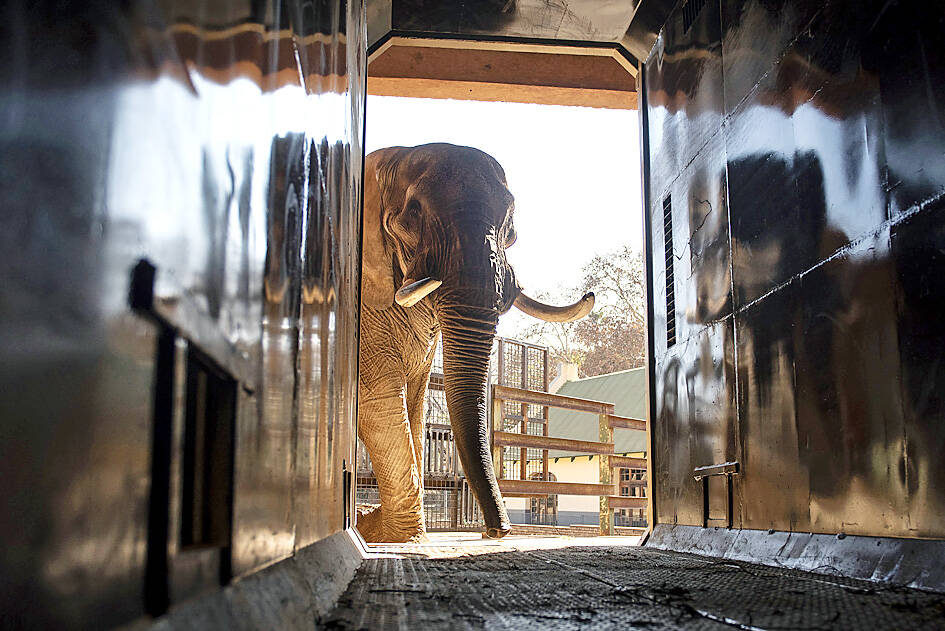When it comes to the niche business of moving elephants, Amir Khalil and his team might be the best.
The Egyptian veterinarian’s resume includes possibly the most famous elephant relocation on the planet. In 2020, Khalil’s team saved Kaavan, an Asian elephant, from years of loneliness at a Pakistan zoo and flew him to a better life with other elephants at a sanctuary in Cambodia.
Kaavan was dubbed the “world’s loneliest elephant” at the time, and the project was a great success. However, he was not the only one that needed help.

Photo: AP
Next up was the last captive elephant in South Africa.
Charley, an aging 4-tonne African elephant, had outlived his fellow elephants at a zoo in the capital, Pretoria, where he had stayed for more than 20 years. Elephants are sensitive animals, wildlife experts say, and Charley was showing signs of being deeply unhappy in his enclosure since his partner, Landa, died in 2020.
Zoo officials decided he should be “retired” to a place more fitting for a big old tusker — a large private game reserve about 200km away where there is a chance he might make some new elephant friends.
How to get him there? Khalil, an animal rescue specialist at the Four Paws wildlife welfare organization, was an obvious choice for this latest mammoth job.
If ever an elephant deserved to enjoy his twilight years, it is Charley.
Captured as a young calf in western Zimbabwe in the 1980s and taken from his herd, he spent 16 years in a South African circus and 23 years as the prime attraction at Pretoria’s National Zoological Garden. He is thought to be 42 years old now and spent 40 of them in captivity.
“I don’t know how many hundreds of thousands of people and children witnessed and enjoyed Charley,” Khalil said. “I think it’s time for him to also enjoy life and to live as an elephant.”
The mechanics of moving an elephant to a new life are complex. Khalil does not dart and tranquilize elephants, mainly because it is not good for such a big animal. Also, four tonnes of tranquilized elephant is hardly any easier to move.
And so, a process began of training an occasionally grumpy old elephant to step willingly into a large metal transport container that would be loaded onto a truck. Khalil and fellow vets Marina Ivanova and Frank Goritz — who were also part of the Kaavan relocation team — first began interacting with Charley two years ago.
That was to assess how ready he was to move and, crucially, to earn his trust. The interaction was carefully controlled, but it involved teaching Charley to respond to calls to walk up to a “training wall” that has gaps in it for the team to offer him a food reward. In Charley’s case, pumpkins, papaya and beetroot are his favorites.
The same process was ultimately used to entice Charley into the transport container. It was thought that it might take months and months for Charley to step happily into the container when that was introduced, but he was ready to go in less than two weeks of crate training last month.
“He was curious, and thinking, what is this new toy?” Ivanova said.
After an hourslong road trip on the back of a truck, Charley was introduced to his new home at the Shambala private game reserve late last month.
He will be held in an area separate from the main park for a few weeks to allow him to settle, the team said, given such a huge change for an old elephant. The park contains wild elephant herds that Charley might join up with.
Khalil said it is still very rare for captive elephants to be reintroduced to a wild setting and praised officials at the Pretoria zoo and South Africa’s environment ministry for allowing this project to go ahead.
“It’s a great message from South Africa that even an old elephant deserves a new chance,” he said.
Khalil’s team has another elephant move in Pakistan planned for next month.
Elephants are highly intelligent, highly social animals, Khalil said, and while Charley was unhappy, he could also be mischievous and playful and show glimpses of delight.
Khalil compared Charley’s last few unfulfilling years at the zoo without any companions to someone watching the same movie every day, alone.
At Shambala, Charley will have the freedom to take a mud bath, roam the bush and be a wild elephant for the first time in four decades with thousands of hectares to explore. Some of his early memories as a calf before he was captured might still be there. The vets said that it is true that elephants have incredible memories.
Charley is already making contact with the other elephants out in the park from his holding pen, Ivanova said.
Elephants have deep rumbles that can be heard5km away that they use to communicate.
“I hear him rumbling,” said Ivanova, delighted. “We’ll help him turn into a wild elephant again.”

PARLIAMENT CHAOS: Police forcibly removed Brazilian Deputy Glauber Braga after he called the legislation part of a ‘coup offensive’ and occupied the speaker’s chair Brazil’s lower house of Congress early yesterday approved a bill that could slash former Brazilian president Jair Bolsonaro’s prison sentence for plotting a coup, after efforts by a lawmaker to disrupt the proceedings sparked chaos in parliament. Bolsonaro has been serving a 27-year term since last month after his conviction for a scheme to stop Brazilian President Luiz Inacio Lula da Silva from taking office after the 2022 election. Lawmakers had been discussing a bill that would significantly reduce sentences for several crimes, including attempting a coup d’etat — opening up the prospect that Bolsonaro, 70, could have his sentence cut to

China yesterday held a low-key memorial ceremony for the 1937 Nanjing Massacre, with Chinese President Xi Jinping (習近平) not attending, despite a diplomatic crisis between Beijing and Tokyo over Taiwan. Beijing has raged at Tokyo since Japanese Prime Minister Sanae Takaichi last month said that a hypothetical Chinese attack on Taiwan could trigger a military response from Japan. China and Japan have long sparred over their painful history. China consistently reminds its people of the 1937 Nanjing Massacre, in which it says Japanese troops killed 300,000 people in what was then its capital. A post-World War II Allied tribunal put the death toll

‘UNWAVERING ALLIANCE’: The US Department of State said that China’s actions during military drills with Russia were not conducive to regional peace and stability The US on Tuesday criticized China over alleged radar deployments against Japanese military aircraft during a training exercise last week, while Tokyo and Seoul yesterday scrambled jets after Chinese and Russian military aircraft conducted joint patrols near the two countries. The incidents came after Japanese Prime Minister Sanae Takaichi triggered a dispute with Beijing last month with her remarks on how Tokyo might react to a hypothetical Chinese attack on Taiwan. “China’s actions are not conducive to regional peace and stability,” a US Department of State spokesperson said late on Tuesday, referring to the radar incident. “The US-Japan alliance is stronger and more

FALLEN: The nine soldiers who were killed while carrying out combat and engineering tasks in Russia were given the title of Hero of the Democratic People’s Republic of Korea North Korean leader Kim Jong-un attended a welcoming ceremony for an army engineering unit that had returned home after carrying out duties in Russia, North Korean state media KCNA reported on Saturday. In a speech carried by KCNA, Kim praised officers and soldiers of the 528th Regiment of Engineers of the Korean People’s Army (KPA) for “heroic” conduct and “mass heroism” in fulfilling orders issued by the ruling Workers’ Party of Korea during a 120-day overseas deployment. Video footage released by North Korea showed uniformed soldiers disembarking from an aircraft, Kim hugging a soldier seated in a wheelchair, and soldiers and officials